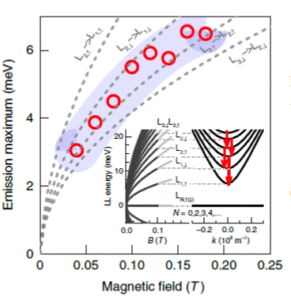THz and Physics
THz waves: a tool for new physics
Terahertz spectroscopy enables us to probe matter and study these physical phenomena of great interest to fundamental science.
In the platform, we apply this spectroscopy to the study of materials with unusual properties that hold many potential applications, such as graphene or "topological insulators", "Dirac semi-metals"... The materials studied, for example, are HgCdTe, InAs/GaSb superlattices, or semiconductor nanowires.
Terahertz waves are composed of very low-energy photons. This energy range corresponds to a large number of excitations in solids, such as phonons, plasmons, magnons, as well as spin transitions or transitions between Landau levels. Terahertz spectroscopy is therefore an efficient way of probing matter and studying these physical phenomena of great interest to fundamental science.
When a quantizing magnetic field is applied to a crystal, it separates the valence and conduction bands into Landau levels. The energy of these levels is proportional to the applied magnetic field when the system has a parabolic band structure, as in semiconductors. On the other hand, the energy of the Landau levels is proportional to the square root of the applied magnetic field when the system has no gap, as in graphene, the surface of topological insulators or in three-dimensional Dirac semimetals. Magneto-absorption spectroscopy experiments in the THz range therefore make it possible to precisely measure the gap or electron mass of these materials. These experiments are of great interest in the study of topological phase transitions in materials such as HgCdTe or InAs/GaSb. For example, we have recently been able to continuously control the mass of electrons in the same crystal, to the point of cancelling it out, by changing its temperature. This discovery enables us to probe the edges of a topological phase transition, during which electrons behave like relativistic elementary particles with a constant, universal velocity.
These parameters were measured using a unique experimental magneto-absorption spectroscopy device, enabling the measurement, as a function of temperature and magnetic field, of very low-energy optical transitions in the THz frequency range. These results point the way both to applications in THz optoelectronics and to new studies of topological insulators.
Suppressed Auger scattering and tunable light emission of Landau-quantized massless Kane electrons
 |
 |
|
| Cyclotron emission spectra measured on a Gapless HgCdTe sample kept in liquid helium at selected values of the magnetic field | Experimentally deduced maxima of emission compared with theoretically expected cyclotron modes . The LL spectrum with schematically depicted emission lines (red arrows) is shown in the inset. |
We have demonstrated cyclotron emission of massless electrons. This emission was observed in gapless HgCdTe - a system hosting 3D massless Kane electrons. The existence of sizeable cyclotron emission is directly related to the particular LL spectrum, which comprises only non-equidistantly spaced levels. Systems hosting massless Kane electrons are thus promising candidates for the active medium of a LL laser, which would, in this particular case, operate in the THz and infrared spectral ranges and would be widely tunable by very low magnetic fields.
D. B. But , M. Mittendorff , C. Consejo, F. Teppe, N. N. Mikhailov, S. A. Dvoretskii, C. Faugeras , S. Winnerl, M. Helm, W. Knap, M. Potemski and M. Orlita
Suppressed Auger scattering and tunable light emission of Landau-quantized massless Kane electrons, Nature Photonics volume 13, pages 783-787(2019)